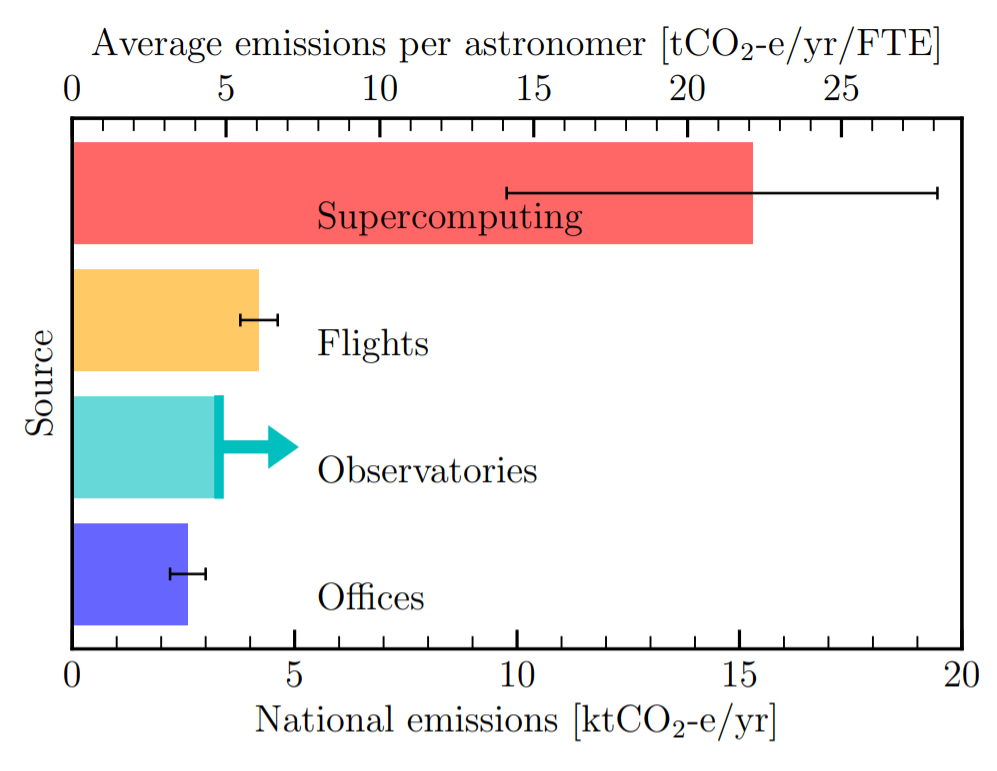
This guest post was written by Isobel Romero-Shaw. Isobel is a PhD student at Monash University in Melbourne, Australia. She tries to figure out how black holes and neutron stars meet up and crash together by studying the vibrations that these collisions send rippling through space-time. This sounds thrilling, but on a day-to-day basis it mainly involves debugging code. When she’s done debugging, Isobel likes to spend time reading, drawing, and exploring.
Although the carbon footprint of the average astronomer might lead you to believe we’re all wearing clown shoes, the situation we find ourselves in is no joke.
The average human being is responsible for the release of about 7 tonnes of CO2 into the atmosphere every year — roughly equivalent to the heft of one fully-grown male elephant. This in itself is a problem; we must reduce our net carbon emissions to zero before 2050 in order to maintain a habitable planet. Nonetheless, the carbon emissions of astronomers put the global average in the shade. In their recent study on the carbon emissions of Australian astronomers, Dr. Adam Stevens et al. found that the average astronomer could be sending more than 37 tonnes of CO2 — that’s five CO2 elephants — spiralling into the sky every year.
Why carbon emissions matter
Carbon dioxide (CO2) is a greenhouse gas: when it gets into the atmosphere it traps the Sun’s heat and warms the planet, like a greenhouse. For most of Earth’s history, atmospheric CO2 levels have been balanced by natural absorption of CO2 by plants and oceans. However, since humans came along, we have been pumping carbon into the atmosphere faster than it can be absorbed.
Human-induced global warming has catastrophic repercussions. In this Canadian White Paper, astronomer Professor Christopher Matzner et al. outline a number of these:
- The rate of melting of Arctic ice is now comparable to the rate of flow of the Mississippi.
- A quarter of all humans now live in areas with a high risk of drought.
- Global warming throws natural weather systems out of balance. In just the last year, we’ve seen unprecedented wildfires tear through much of Australia and the Amazon rainforest, and Cyclone Amphan devastate large swathes of India, Sri Lanka and Bangladesh.
- As parts of the world become uninhabitable for humans, others will become overpopulated, and we can expect over 140 million climate refugees to seek new homes by 2050.
- For non-human flora and fauna, climate-related habitat loss has already triggered Earth’s sixth mass extinction event.
Awareness of the severity of global warming has grown rapidly in recent years, in part due to movements like the School Strikes for Climate — led by renowned teen activist Greta Thunberg — and Extinction Rebellion. In January 2020, over 12500 scientists from 153 countries signed the World Scientists’ Warning of a Climate Emergency. As of February 2020, 197 countries have signed the Paris Agreement, which aims to limit global warming to less than 2°C above pre-industrial temperatures before the year 2100. But just being aware of the issue is not enough. We have a lot of work to do before our emissions hit the Paris targets – especially in astronomy.

Emissions in astronomy
Observing facilities take partial blame for the comparatively high emission levels of astronomers. According to the Australian study, about 13% of total astro emissions — one small elephant’s worth – comes from the operation of observatories, while only 10% comes from powering our office buildings.
More concerning, though, is how much carbon we emit through work-related travel. Our flying habits make up a large fraction of our total emissions, especially in large countries like Australia, Canada and the United States, where we often fly interstate as well as overseas. In Australia, flights make up 17% of our work-related emissions. This is somewhat due to the remote location of Australia – using Qantas’s carbon emissions calculator, Stevens found that a single round trip from Australia to the US or Europe can easily exceed 3 tonnes of CO2 per passenger. Even for astronomers living in less remote countries like Canada, Matzner points out that a typical transatlantic flight uses seven months’ worth of the annual per-capita emissions needed to reach the Paris targets.

Shockingly, the carbon cost of air travel is small change in comparison to the big bucks splashed on high performance computing. As a theoretical astronomer, you might think that your stellar simulations have no real ties to the material world. Yet the Australian study found that 60% of astro emissions come from supercomputer usage alone. More than three times the amount generated through our air travel, the CO2 generated just by powering and cooling computer clusters equates to three carbon elephants per astronomer.
Prevention is better than cure
While climate change impacts all of us as inhabitants of planet Earth, it’s vital to remember that it also threatens astronomical study. As explained in this American White Paper led by Dr. Kathryn Williamson, many of our activities depend on relatively stable weather conditions: extreme weather events leave ground-based telescopes and observatories out-of-action.
If we fail to combat climate change, then we depend on proposed mitigation strategies to keep our planet habitable. Some of these, like injecting aerosols into the stratosphere to reduce solar flux, will also render our ground-based telescopes close to useless. According to one recent study, such an aerosol injection would increase the night sky brightness by 25%, in addition to doubling the level of starlight scattering in the atmosphere. The profession of astronomy is jeopardy unless we seriously change our behaviour, and we must do it now.
A sustainable future for astronomy
We exist at a moment of balance — an unstable solution — where small actions that we take now could tip us into one of two very different futures. Here are just a few measures suggested by the papers referenced in this post that might tilt the balance in favour not only of astronomy, but of humanity.
As an individual
- Reduce your own carbon footprint. Use a carbon footprint calculator to figure out how and where to reduce the carbon consumption of your lifestyle.
- Eat less meat. If all humans were to adopt a diet low or completely devoid of animal products, global CO2 emissions could reduce by almost 30%.
- Advocate for the climate. Most people don’t think about climate change on a daily basis, so don’t acknowledge their own CO2 elephants. Raise awareness by starting conversations with friends and family.
As an astronomer
- Incorporate climate science into Astro 101. The ‘Introduction to Astronomy’ module will be their last formal science class taken by many undergraduates, who will go on to become politicians, lawyers, teachers, and voters. Climate science can naturally be incorporated into lessons on topics like exoplanet habitability and spectroscopy.
- Take responsibility for your flights. Physically attending conferences is often touted as a game-changer for early-career researchers, but recent research shows that that’s not the case. Only fly if there is no other transportation option, fly economy, and offset your emissions.
- Switch to cloud computing. Not only is cloud computing cheaper than cluster computing, it can also reduce carbon emissions by a factor of nine.
In your workplace
- Encourage implementation of sustainable energy solutions. A golden example of this is the University of Queensland, which has an offsite solar farm that will provide 100% of the University’s energy requirements by the end of 2020.
- Pressure your institution to make any new builds at least carbon-neutral, if not carbon-negative, like the Center for Interactive Research on Sustainability at the University of British Columbia.
- Petition your institution to cut ties with fossil fuel companies. Although universities worldwide have generally acknowledged and vowed to combat climate change, many remain invested in fossil fuel companies and/or banks that finance fossil fuel companies.
In the wider astronomical community
- Embrace virtual conferencing. If there is a silver lining to the COVID-19 pandemic, it is that it has taught us that we can very efficiently adapt to networking remotely. Many conferences have already been, or will be, run entirely online — recent and upcoming meetings of the European Astronomical Society, American Astronomical Society, and Astronomical Society of Australia are examples. New software like VirBELA is making entirely-virtual conferencing possible, while hardware like BeamPro offers a way to encourage some remote participation in a ‘blended’ physical/virtual approach.
- Incorporate climate science into public talks. Astronomy is one of the most appealing sciences to the general public, and more than 146 million people attend planetarium talks annually. ‘Dynamic Earth: Exploring Earth’s Climate Engine’ is a free-to-use video including NASA visualisations that is shown at more than 175 planetariums around the world.
- Build a culture where sustainability is celebrated. All three of the papers featured in this article suggest building sustainability into grants, funding applications and awards as an incentive. Prioritise the research that prioritises the planet, to ensure that the next generation of astronomers still have a planet from which to look to the stars.
If you are an astronomer, consider signing up with the grass-roots movement Astronomers for Planet Earth.


